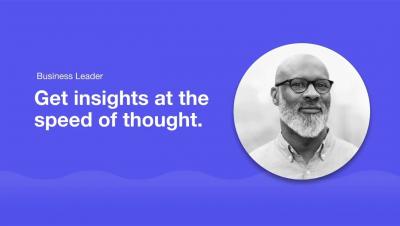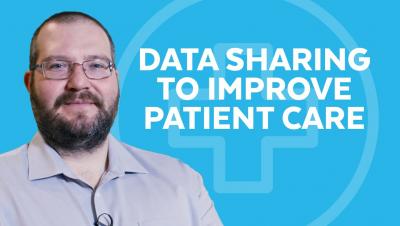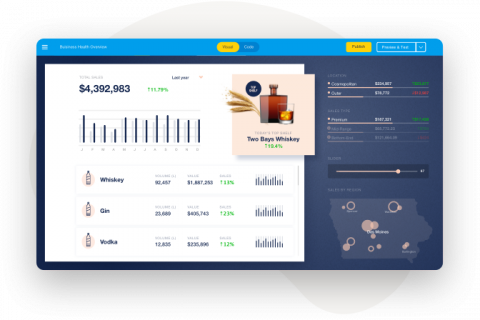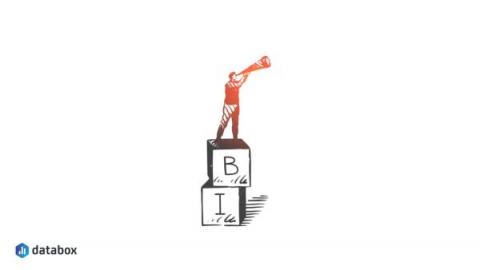Systems | Development | Analytics | API | Testing
May 2022
How to Lead with Data | The Data Cloud Podcast
Why You Need More Than Data Visualization Tools for Business Intelligence
Built with BigQuery: Gain instant access to comprehensive B2B data in BigQuery with ZoomInfo
Editor’s note: The post is part of a series highlighting our partners, and their solutions, that are Built with BigQuery. To fully leverage the data that’s critical for modern businesses, it must be accurate, complete, and up to date. Since 2007, ZoomInfo has provided B2B teams with the accurate firmographic, technographic, contact, and intent data they need to hit their marketing, sales, and revenue targets.
Everything you know about data health is wrong
If someone asked you what makes data “healthy”, what would you say? What IS data health? Healthy data just means data that is quality, accessible, trusted, and secure, right? Wrong. Let's dissect. Data health really has nothing to do with the data itself, if you think about it.
Eliminating Data Myths with Analytics Modernization
Quick Qlik - Qlik Sense Mobile Design Tips and New Landscape Mode
Anodot Named by Forrester in Future of Business Intelligence Report
It’s hard to believe enterprise BI platforms have been around for three decades. In that time, they have served the purpose of collecting and analyzing large amounts of data to help businesses make more informed decisions. But in today’s data-driven economy, analysts struggle to keep up with the myriad of business intelligence reports from traditional BI tools – which fail to effectively and efficiently analyze and interpret data in real-time.
How to Overcome Hybrid Cloud Migration Roadblocks
Snowpark for Python: Bringing Efficiency and Governance to Polyglot ML Pipelines
Machine learning (ML), more than any other workflow, has imposed the most stress on modern data architectures. Its success is often contingent on the collaboration of polyglot data teams stitching together SQL- and Python-based pipelines to execute the many steps that take place from data ingestion to ML model inference.
Building a Killer App with White Label BI
Yext Relies on Snowflake to Create User-Friendly Search Experiences
Get value from data quickly with Informatica Data Loader for BigQuery
If data is currency in today’s digital environment, then organizations should waste no time in making sure every business user has fast access to data-driven insights.
Tailored Support Designed for You
At Cloudera we’re building the world’s only hybrid data platform that’s founded on open source and truly hybrid. What do we mean by truly hybrid? Well, not only does it seamlessly support on-premises and cloud-based deployments alike, but uniquely, it is cloud vendor agnostic, allowing multi-cloud strategies to thrive.
Virgin Media Ireland Scales Up to Empower Local Operations with Snowflake's Data Cloud
Technology Spotlight - Tailored Support Designed for You
What's new in ThoughtSpot Analytics Cloud 8.3.0
National Stock Exchange (NSE) uses Qlik to identify actionable alerts and take informed decisions
The importance of partnering together - Alyssa Fitzpatrick
NHS GMHSCP Provides Support To 3 Million Patients With Snowflake
Making Sense of Qlik APIs- Qlik CLI
Bringing Dark Data to Light
At least every few years, utility companies release squadrons of drones into the skies to digitally photograph hard-to-reach equipment and check for wear and tear. Around the world, there are 3 million miles of high-voltage transmission lines – enough to go from the moon and back half-a-dozen times – and as much as 64 million miles of local transmission lines; that represents a lot of images, and even more data.
The changing landscape of data technology - Greg Khairallah
How To Use Data To Reinvent Retail
Built with BigQuery: Material Security's novel approach to protecting email
Since the very first email was sent more than 50 years ago, the now-ubiquitous communication tool has evolved into more than just an electronic method of communication. Businesses have come to rely on it as a storage system for financial reports, legal documents, and personnel records. From daily operations to client and employee communications to the lifeblood of sales and marketing, email is still the gold standard for digital communications.
6 Signs You Have the Wrong Business Intelligence Platform
How Snowflake Support Uses Data to Improve the Customer Experience
Customer advocacy is one of the Snowflake Support team’s most important roles. Working closely with customers around the world every day, we listen and learn to gain meaningful insights into Snowflake products, the ways our customers use those products, and the challenges they face. We feel a deep responsibility to take those insights and trends, analyze them, and drive positive change on behalf of Snowflake customers.
Unlock real-time insights from your Oracle data in BigQuery
Relational databases are great at processing transactions, but they’re not designed to run analytics at scale. If you're a data engineer or a data analyst, you may want to continuously replicate your operational data into a data warehouse in real time, so you can make timely, data driven business decisions.
How to establish data excellence
Canadian Tire x ThoughtSpot
Becoming AI-First: How to Get There
Deciding to adopt an AI-first strategy is the easy part. Figuring out how to implement it takes a little more effort. It requires a clear-eyed vision built around well-defined goals and a realistic execution plan. Being AI-first means setting up your organization for the future. By leveraging data, analytics, and automation, a company can gain a better understanding of where it is and where it needs to go.
IT vs Shadow IT - Between 2 bits ep. 01
The Best Time to Kickstart your Data Strategy is Now
SaaS in 60 - Chart-level Scripting
Snowflake Scripting
Spring '22: Accelerate productivity, work smarter, and establish data excellence at scale
At Talend, we hear every day from our customers that healthier data makes it easier to increase revenue, reduce costs, and mitigate risk. But the journey to healthier data isn’t always easy. To support healthy data, organizations must unify data activities across users with different skill sets and levels of technical expertise through intelligence and self-service capabilities.
Qlik Data Integration and Microsoft Azure Accelerate the Value of SAP Data
Build End-To-End Data Pipelines With Snowflake
Systems development lifecycle (SDLC) with the Qlik Active Intelligence Platform - Part 2
Analytics For Anyone, Anywhere: How Yellowfin Solves The BI Adoption Problem
How technology plays a part in our "New Normal" - Wendy Pfeiffer
Why Legacy Observability Tools Don't Work for Modern Data Stacks
Whether they know it or not, every company has become a data company. Data is no longer just a transactional byproduct, but a transformative enabler of business decision-making. In just a few years, modern data analytics has gone from being a science project to becoming the backbone of business operations to generate insights, fuel innovation, improve customer satisfaction, and drive revenue growth. But none of that can happen if data applications and pipelines aren’t running well.
Before You Embed Analytics: An Essentials Checklist
Quick Qlik - Set Analysis with Measures!
Software.com Helps Improve Developer Productivity
Previewing the power of BigQuery Remote Functions for drive time optimization
BigQuery's Remote Functions (in preview) make it possible to apply custom cloud functions to your warehouse without moving data or managing compute. This flexibility unlocks many use cases including data enrichment. In this post we demonstrate a pattern for combining BigQuery with the Google Maps API to add drive times to datasets containing origin and destination locations. This enrichment pattern is easily adapted for address geocoding or adding Google Map's place descriptions to locations.
Extending BigQuery Functions beyond SQL with Remote Functions, now in preview
Today we are announcing the Preview of BigQuery Remote Functions. Remote Functions are user-defined functions (UDF) that let you extend BigQuery SQL with your own custom code, written and hosted in Cloud Functions, Google Cloud’s scalable pay-as-you-go functions as a service. A remote UDF accepts columns from BigQuery as input, performs actions on that input using a Cloud Function, and returns the result of those actions as a value in the query result.
ThoughtSpot Expands the Modern Analytics Cloud to Help Companies Dominate the Decade of Data
ThoughtSpot Launches New Editions for Individuals and Teams to Democratize the Modern Analytics Cloud
Using Snowpark As Part Of Your Machine Learning Workflow
Why Drag and Drop Analytics are Important for Seamless BI Reporting
AT&T Connects the World in the Data Cloud
Optimizing Hive on Tez Performance
Tuning Hive on Tez queries can never be done in a one-size-fits-all approach. The performance on queries depends on the size of the data, file types, query design, and query patterns. During performance testing, evaluate and validate configuration parameters and any SQL modifications.
Forrester: How App Modernization is Speeding Cloud Deployment
Hitachi Vantara recently commissioned Forrester Consulting to conduct a Total Economic Impact (TEI) study to examine the value that customers could achieve using cloud and application modernization services from Hitachi Vantara. To better understand the benefits, costs, and risks associated with this investment, Forrester interviewed four decision-makers at companies with experience using cloud and app modernization services from Hitachi Vantara.
Redefining File Services from Edge to Core to Cloud
The idea of running compute and storing data in the cloud is no longer a novel concept. With the evolution of 5G and Internet of Things (IoT), this brings along the next evolution of edge storage demands. Today, around 10% of enterprise-generated data is created and processed outside a traditional centralized data center or cloud. By 2025, Gartner predicts this figure will reach 75%.
Roundtable Recap: DataOps Just Wanna Have Fun
We like to keep things light at Unravel. In a recent event, we hosted a group of industry experts for a night of laughs and drinks as we discussed cloud migration and heard from our friends at Don’t Tell Comedy. Unravel VP of Solutions Engineering Chris Santiago and AWS Sr. Worldwide Business Development Manager for Analytics Kiran Guduguntla moderated a discussion with data professionals from Black Knight, TJX Companies, AT&T Systems, Georgia Pacific, and IBM, among others.
Webinar Recap: Succeeding with DataOps
The term DataOps (like its older cousin, DevOps) means different things to different people. But one thing that everyone agrees on is its objective: accelerate the delivery of data-driven insights to the business quickly and reliably.
The Missing Link in Your Power BI/ERP Data Chain
Business intelligence empowers businesses to get the most out of their data by providing tools to analyze information, streamline operations, track performance, and inform decision-making. In the Microsoft Dynamics ecosystem, Power BI generates easy-to-read visualizations that help stakeholders perform key analysis. But finance professionals can encounter roadblocks when seeking deeper analysis than their technical knowledge of Power BI permits.
Yellowfin's Commitment Expands from Embedded BI to BI Applications
Hadoop vs. Redshift: What You Need to Know
Now generally available: BigQuery BI Engine supports many BI tools or custom application
Customers who work with data warehouses, running BI on large datasets used to have to pick low latency but trading off freshness of data. With BigQuery BI Engine, they can accelerate their dashboards and reports that connect to BigQuery without having to sacrifice freshness of the data. Using the latest insights helps them make better decisions for the business.
Winning With Data in the Fight Against Fraud, Waste, and Abuse
Fraud, waste, and abuse (FWA) in government is a constant, multi-billion dollar issue that challenges agency leaders at all levels and across all sectors, from healthcare to education to taxation to Social Security. The scope and scale of public spending—federal outlays alone were approximately $6.6 trillion in fiscal year 2020 according to the Congressional Budget Office—make FWA an inherently difficult problem to solve.
Business Intelligence Reporting: Definition, Benefits and Best Practices
Data governance in action: Beneva
Marketing based on the next best action requires effective data handling for success. For Canadian insurer, Beneva, however, silos were standing squarely in the way. With over three million customers and CA$13 billion in assets, Beneva is one of Canada’s largest financial institutions. They had over 75 years of product and customer data, but that data was isolated in various systems, databases, and customer portals.
A CFO's Perspective: Understanding The Positive Business Impact of a Modern Financial Analytics Approach
I recently sat down with CFODive to discuss the importance of modern financial analytics in transforming the way financial leaders and their organizations operate – a topic that is only becoming increasingly prominent. Business strategies have had to rapidly adjust to address market volatility, consumer trends, and unpredictable world events. These dynamics have forced finance teams to rethink how they are using data and analytics and take a more modern approach.
How Piano Helps Companies Use Captured Data to Understand Customer Behavior
Technical intro to Cortex Data Foundation for SAP with BigQuery
Billie Boosts Innovation With Snowflake Data Cloud
AI-First Benefits: 5 Real-World Outcomes
Artificial intelligence (AI) has been a focus for research for decades, but has only recently become truly viable. The availability and maturity of automated data collection and analysis systems is making it possible for businesses to implement AI across their entire operations to boost efficiency and agility. AI has the potential to transform operations by improving three fundamental business requirements: process automation, decision-making based on data insights, and customer interaction.
Qlik Application Automation (Part 2)
How to turn integrated data into an integrated experience
Talend has a lot in common with our customers. We collect a whole lot of data. We take pride in how we use that data. And we’re always looking for new ways to drive better business outcomes with our data. That is why Talend recently launched the Digital Touchpoint Model (DTM) initiative to create an exceptional, data-driven, “One Talend” support experience for customers, using our own products and innovative best practices.
Lightweight Batch Streaming
Uniper: Enabling Governed Self-Service
5 Benefits of Low-Code, No-Code BI Solutions
Choose Compliance, Choose Hybrid Cloud
As digital transformation accelerates, and digital commerce increasingly becomes the dominant form of all commerce, regulators and governments around the world are recognizing the increased need for consumer protections and data protection measures.


































































